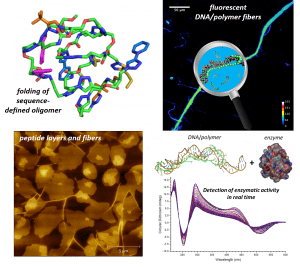Bio-inspired chemistry and structures
Nature offers a diversity of inspiring structures and functions that can guide us to develop sophisticated materials for current challenges in energy, environment, health, and information technologies.
Within the Laboratory for Chemistry of Novel Materials, we take inspiration from living systems to design bioinspired and biohybrid (nano)materials, towards prospective applications in biosensors, bioadhesives, delivery systems, catalysts, etc.
Our joint experimental and molecular modeling approach allows us to establish relationships between supramolecular organization, properties, and functions. Processes such as recognition, templating, chirality transfer, self-assembly, and cooperativity are studied across different length- and time-scales, which is fundamental to achieve complex and adaptive materials as those found in biomolecular constructs.
Current examples of bioinspired and biohybrid materials under study:
- DNA-templated dynamic assemblies and switches for delivery applications
- DNA /p-conjugated molecules assemblies for optical biodetection (aptamer-based or hybridization sensors, enzymatic assays, and G-quadruplexe probes)
- Sea star-inspired and polymer coatings for bioadhesives
- Molecular design of optoelectronics materials inspired from DNA binders
- Peptide-based chiral fibers, surfaces, and hydrogels
- Sequence-defined oligomers/polymers for biorecognition and catalysis

A few recent publications:
Photomodulation of DNA-templated supramolecular assemblies
J. Rubio-Magnieto, T.-A. Phan, M. Fossépré, V. Matot, J. Knoops, T. Jarrosson, P. Dumy, F. Serein-Spirau, C. Niebel, S. Ulrich, M. Surin, Chem. Eur. J. 2018, 24, 706. https://doi.org/10.1002/chem.201704538
Repurposing DNA binding agents as H-Bonded organic semiconductors
F. Zhang, V. Lemaur, W. Choi, P. Kafle, S. Seki, J. Cornil, D. Beljonne, and Y. Diao, Nat. Commun. 2019, 10, 4017. https://doi.org/10.1038/s41467-019-12248-9
Detection of the enzymatic cleavage of DNA through supramolecular chiral induction to a cationic polythiophene
M. Fossépré, M. Trévisan, V. Cyriaque, R. Wattiez, D. Beljonne, S. Richeter, S. Clément, M. Surin, ACS Appl. Bio Mater. 2019, 2, 2125. https://doi.org/10.1021/acsabm.9b00123
A cationic tetraphenylethene as a light-up supramolecular probe for DNA G-quadruplexes
C. Kotras, M. Fossépré, M. Roger, V. Gervais, S. Richeter, P. Gerbier, S. Ulrich, M. Surin, S. Clément, Front. Chem. 2019, 7, 493. https://doi.org/10.3389/fchem.2019.00493
Sea star-inspired recombinant adhesive proteins self-assemble and adsorb on surfaces in aqueous environments to form cytocompatible coatings
M. Lefevre, P. Flammang, S. Aranko, M.B. Linder, T. Scheibel, M. Humenik, M. Leclercq, M. Surin, L. Tafforeau, R. Wattiez, Ph. Leclère, E. Hennebert, Acta Biomaterialia 2020, 112, 62. https://doi.org/10.1016/j.actbio.2020.05.036
Discrete multifunctional sequence-defined oligomers with controlled chirality
J. Li, M. Leclercq, M. Fossépré, M. Surin, K. Glinel, A.M. Jonas, A.E. Fernandes, Polymer Chemistry, 2020, 11, 4040-4046. https://doi.org/10.1039/D0PY00537A
